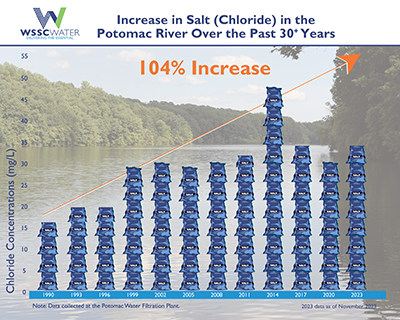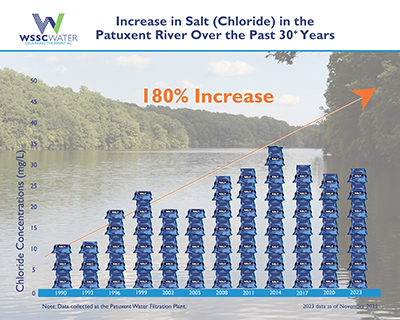Be Salt Wise in Winter
When winter weather hits, avoid using too much salt to fight the snow and ice. Because that salt can contaminate drinking water, harm aquatic plants and animals, and damage metal and concrete.
When winter weather hits, avoid using too much salt to fight the snow and ice. Because that salt can contaminate drinking water, harm aquatic plants and animals, and damage metal and concrete.
Most people know that salt is effective in melting snow and ice and keeps our roadways safe in the winter. But many people may not realize that the salt we use on sidewalks, driveways and roads is harmful to the environment. Salt doesn’t just go away when the snow/ice melts. It seeps into the ground and wells, and travels with stormwater into streams and eventually into our drinking water sources – the Potomac and Patuxent Rivers.
WSSC Water closely monitors the water entering our Patuxent and Potomac Water Filtration Plants and we’ve noticed that over the last 30 years, the average salt levels (sodium and chloride are the two components of salt) have been steadily increasing. The levels peak in the winter months and are higher in years that see more winter weather events. Once sodium or chloride enters our drinking water sources, we cannot remove it during the water filtration process.
 |  |
Damage Salt Causes
What is the impact on human health?
Sodium in drinking water is not a health concern for most of us, but the U.S. Environmental Protection Agency recommends sodium in drinking water be less than 20 milligrams per liter for those on severely restricted sodium diets. We recommend you talk to your doctor if you have medical conditions sensitive to sodium levels, such as high blood pressure or kidney disease.
Do your part to keep excess salt out of local waterways
Learn what you can do to avoid over-using road salt that can contaminate drinking water, harm aquatic plants and animals, and damage metal and concrete.
In the last five years, the State Highway Administration has reduced its overall salt usage by half. See what it and Maryland's Department of the Environment are doing to manage road salt.